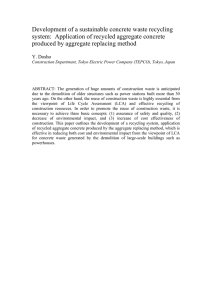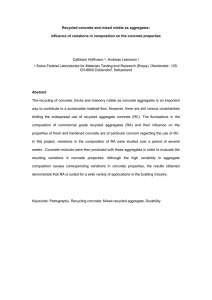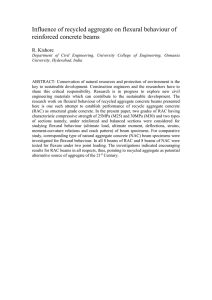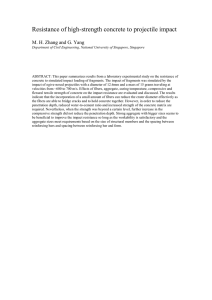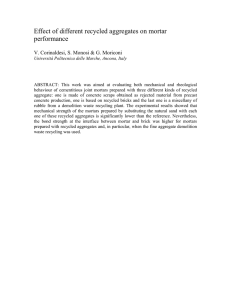Recycled Aggregate Concrete: Strength & Sustainability
advertisement
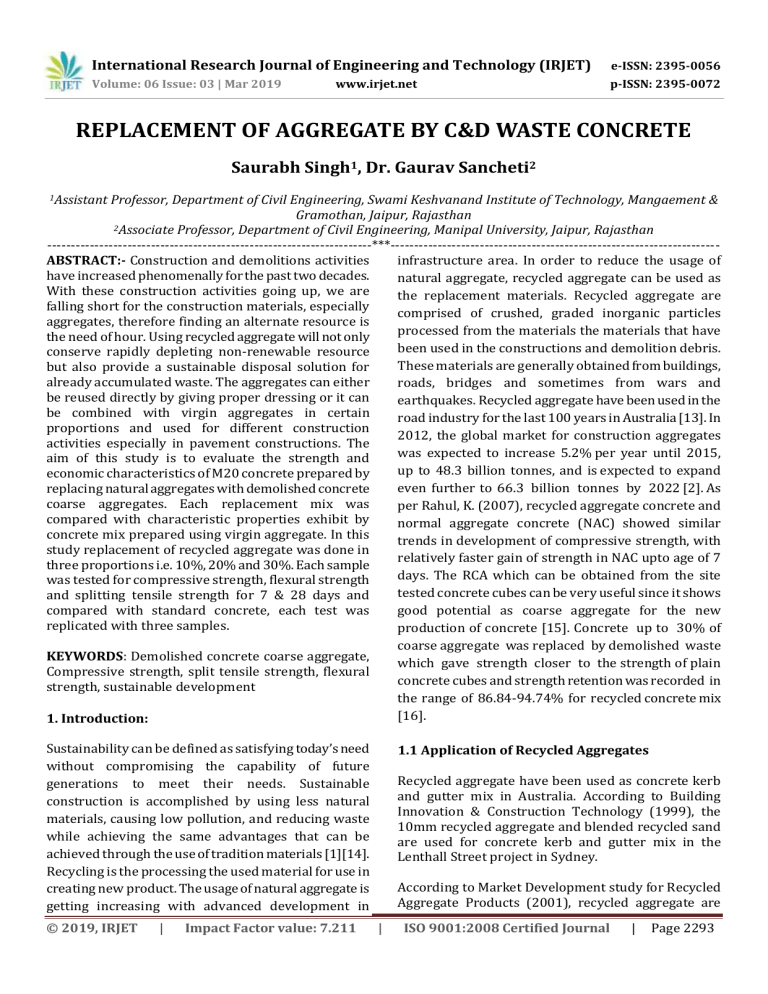
International Research Journal of Engineering and Technology (IRJET) e-ISSN: 2395-0056 Volume: 06 Issue: 03 | Mar 2019 p-ISSN: 2395-0072 www.irjet.net REPLACEMENT OF AGGREGATE BY C&D WASTE CONCRETE Saurabh Singh1, Dr. Gaurav Sancheti2 1Assistant Professor, Department of Civil Engineering, Swami Keshvanand Institute of Technology, Mangaement & Gramothan, Jaipur, Rajasthan 2Associate Professor, Department of Civil Engineering, Manipal University, Jaipur, Rajasthan ---------------------------------------------------------------------***---------------------------------------------------------------------ABSTRACT:- Construction and demolitions activities infrastructure area. In order to reduce the usage of have increased phenomenally for the past two decades. natural aggregate, recycled aggregate can be used as With these construction activities going up, we are the replacement materials. Recycled aggregate are falling short for the construction materials, especially comprised of crushed, graded inorganic particles aggregates, therefore finding an alternate resource is processed from the materials the materials that have the need of hour. Using recycled aggregate will not only been used in the constructions and demolition debris. conserve rapidly depleting non-renewable resource These materials are generally obtained from buildings, but also provide a sustainable disposal solution for already accumulated waste. The aggregates can either roads, bridges and sometimes from wars and be reused directly by giving proper dressing or it can earthquakes. Recycled aggregate have been used in the be combined with virgin aggregates in certain road industry for the last 100 years in Australia [13]. In proportions and used for different construction 2012, the global market for construction aggregates activities especially in pavement constructions. The was expected to increase 5.2% per year until 2015, aim of this study is to evaluate the strength and up to 48.3 billion tonnes, and is expected to expand economic characteristics of M20 concrete prepared by even further to 66.3 billion tonnes by 2022 [2]. As replacing natural aggregates with demolished concrete coarse aggregates. Each replacement mix was per Rahul, K. (2007), recycled aggregate concrete and compared with characteristic properties exhibit by normal aggregate concrete (NAC) showed similar concrete mix prepared using virgin aggregate. In this trends in development of compressive strength, with study replacement of recycled aggregate was done in relatively faster gain of strength in NAC upto age of 7 three proportions i.e. 10%, 20% and 30%. Each sample days. The RCA which can be obtained from the site was tested for compressive strength, flexural strength tested concrete cubes can be very useful since it shows and splitting tensile strength for 7 & 28 days and compared with standard concrete, each test was good potential as coarse aggregate for the new replicated with three samples. production of concrete [15]. Concrete up to 30% of coarse aggregate was replaced by demolished waste KEYWORDS: Demolished concrete coarse aggregate, which gave strength closer to the strength of plain Compressive strength, split tensile strength, flexural concrete cubes and strength retention was recorded in strength, sustainable development the range of 86.84-94.74% for recycled concrete mix [16]. 1. Introduction: Sustainability can be defined as satisfying today’s need without compromising the capability of future generations to meet their needs. Sustainable construction is accomplished by using less natural materials, causing low pollution, and reducing waste while achieving the same advantages that can be achieved through the use of tradition materials [1][14]. Recycling is the processing the used material for use in creating new product. The usage of natural aggregate is getting increasing with advanced development in © 2019, IRJET | Impact Factor value: 7.211 1.1 Application of Recycled Aggregates Recycled aggregate have been used as concrete kerb and gutter mix in Australia. According to Building Innovation & Construction Technology (1999), the 10mm recycled aggregate and blended recycled sand are used for concrete kerb and gutter mix in the Lenthall Street project in Sydney. According to Market Development study for Recycled Aggregate Products (2001), recycled aggregate are | ISO 9001:2008 Certified Journal | Page 2293 International Research Journal of Engineering and Technology (IRJET) e-ISSN: 2395-0056 Volume: 06 Issue: 03 | Mar 2019 p-ISSN: 2395-0072 www.irjet.net used as granular base course in the road construction and proved to be better than natural aggregates on wet subgrade in terms of stabilizing the base and improved working surface for pavement structure construction. Recycled aggregate can be used in embankment fill. The reason for being able to use in embankment fill is same as it is used in granular base course construction. Recycled aggregate have been used as paving blocks in Hong Kong. According to Housing Department recycled aggregate are used as typical paving blocks (2002). Mehus and Lillestl found that Norwegian Building Research Institute mentioned that recycled concrete aggregate can be used as backfill materials in the pipe zone along trenches after having testing in laboratory. Figure 1 shows the diagrammatic representation of natural and recycled aggregates. 1.3 Indian Status There is severe shortage of infrastructural facilities like houses, hospitals, road etc. in India and the need of quantities of construction materials for creating these facilities is large. The planning Commission allocated approximately 50% of capital outlay for infrastructure development in successive 10th and 11th five year plans. Central Pollution Control Board has estimated current quantum of solid waste generation in India of 48 million tons per annum out of which, waste from construction industry only accounts for more than 25%. The total quantum of waste from construction industry is estimated to be 12 to 14.7 million tons per annum out of which 7-8 million tons are concrete and brick waste. According to findings of a survey, 70% of the respondent have given the reason for not adopting recycling of waste from construction industry is “Not aware of the recycling techniques” while remaining 30% have indicated that they are not even aware of recycling possibilities. 1.4 Necessity for the use of recycled concrete aggregates Figure 1. Natural and Recycled Aggregates 1.2 Advantages of Recycled Aggregates The major reasons for the increase of demolition concrete waste are: There are many benefits to using recycled aggregates. Use of recycled aggregates over natural materials can save money as they are less expensive to produce. Producing recycled aggregate for resale is more cost-effective than sending un-wanted materials to landfill and incurring landfill tax. Recycled Aggregate is regarded to be a ‘green’ construction material. Using recycled aggregate reduces the amount of virgin aggregates which are created and therefore means less use of natural resources. There is increasing pressure on landfill capacity, and pressure on construction sites to divert waste away from landfill to meet sustainability targets. So use of recycled aggregates conserves landfill space, reduces the need for new landfills. © 2019, IRJET | Impact Factor value: 7.211 Studies proved that Recycled Aggregate is as structurally reliable as natural aggregate and is as safe to use. Many old building and other structures have overcome their limit of use and need to be demolished. Structures, even adequate to use, are under demolition, becomes there are new requirements and necessities such as new earthquake zones. Creation of building wastes which result from natural destructive phenomena such as earthquakes, storms etc. The basic composition of demolition waste according to Meddah (2017) is shown in figure 2. | ISO 9001:2008 Certified Journal | Page 2294 International Research Journal of Engineering and Technology (IRJET) e-ISSN: 2395-0056 Volume: 06 Issue: 03 | Mar 2019 p-ISSN: 2395-0072 www.irjet.net Figure 3 shows the clear difference between the recycled coarse aggregate and natural virgin coarse aggregate. In recycled coarse aggregate it contain old attached adhered mortar on the surface of aggregate but surface of natural virgin coarse aggregate is free from adhered mortar. Figure 2. Composition of Demolition Waste. 2. MATERIALS AND METHODS In the design of conventional concrete the selection of proper ingredients, evaluating their properties and understanding the interaction between different materials plays a major role in performance of the concrete. The ingredients used in the study are cement, natural sand, coarse aggregate, demolished concrete waste in the form of coarse aggregate. Figure 3: Process of using recycled Aggregate in Concrete [17] 2.3 Preparation of Specimens Concrete mix proportions of ratio 1:1.5:3 (M20) is used for the preparation of specimens. Conventional specimens were casted. Recycled aggregate specimens is prepared where the coarse aggregate is replaced by the recycled coarse aggregate from concrete waste of about 10%, 20%, 30%. The specimens were cured by using tap water at room temperature and tested at the age of 7 and 28 days. 2.1 Demolished concrete waste The concrete obtained using demolished waste aggregate satisfies the minimum requirements of new bought aggregates. Concrete using demolished waste aggregates resulted in acceptable strength required for structural concrete. The Demolished waste-cement composite is compatible and no pre-treatment is required. 3. MIX DESIGN A mix design is a method of calculating the amount of coarse aggregate, fine aggregate, cement content and water content is calculated by using the experimental values obtained. The demolished waste was obtained from a construction site. They are dried for few days before being crushed manually. The crushed materials are later transported to the laboratory where they were washed and allowed to dry under ambient temperature for several hours. Coarse aggregates show a wide diversity in size, weight, shape, and colour, depending on the crushing. DESIGN STIPULATIONS: Mix of concrete is M20. The fck valve is 20 N/mm2. Consider maximum aggregate size is 20mm. Degree of workability = 0.90 (compaction factor) Type of Exposure = Mild exposure 2.2 Recycled Aggregate Aggregate typically processed by the crushing of parent or old concrete such as demolished waste concrete is regarded as recycled concrete aggregate (RCA). Generally RCAs are mixed with bricks, tiles, metals and other miscellaneous such as glass, wood, paper, plastic and other debris [17]. © 2019, IRJET | Impact Factor value: 7.211 TEST DATA OF MATERIAL: Specific gravity of cement = 3.15 Specific gravity of CA = 2.63 Specific gravity of RFA = 2.45 | ISO 9001:2008 Certified Journal | Page 2295 International Research Journal of Engineering and Technology (IRJET) e-ISSN: 2395-0056 Volume: 06 Issue: 03 | Mar 2019 p-ISSN: 2395-0072 www.irjet.net Water absorption: 4. TESTS ON AGGREGATE CA = 0.5 % RFA = 1.8 % Free (surface) moisture: CA = nil RFA = 1% Sand conforming to Zone I. (RFA- RECYCLED FINE AGGREGTAE) I) Impact Strength Test (IS: 2386 (Part IV) – 1963) Aggregates Impact strength is determined by impact testing machine. Impact value of fresh aggregates and recycled aggregate are shown in table 2. Table 2: Impact Value of Fresh Aggregates and Recycled Aggregate. MIX DESIGN CALCULATIONS: TARGET MEAN STRENGTH: fck ’ = fck + (t*s) fck ’ = 20 + ( 1.65*4) S.NO. Particulars Impact Value 1 Fresh Aggregates 20 S, t obtained from IS 10262-2009 Target mean strength = 26.6 Mpa 2 Recycled Aggregates 23 WATER CEMENT RATIO: II) From IS 10260-2009 the water/cement ratio is obtained as 0.50 From the above values the amount of water content is 186 kg and the percentage of sand is 34.5% Crushing Strength Test (IS: 2386 (Part IV) – 1963) Aggregates Crushing strength is determined by compressive testing machine. Crushing value of fresh aggregates and recycled aggregate are shown in table 3. Concrete Mixes Conventional Cubes: Volume of each cube = 3.375 x 10 m3 Volume of 3 cubes = 10.125 x 10 m3 Quantity of materials required (considering 10 % loss) Cement = 5 kg Sand = 7.7 kg Coarse aggregates =15.7 kg Water = 2.5 lit The mix design is calculated and the amount of aggregate need for 9 cubes is calculated. The mix is done by hand by adding water at different interval. Table 1 shows proportion of each mix materials for six cubes. Table 3: Crushing Strength of Fresh Aggregates and Recycled Aggregate. Table 1: Proportion of each mix materials for six cubes III) 30% 20% 10% 0% Cement 9.9kg 9.9kg 9.9kg 9.9kg © 2019, IRJET Sand 21.72kg 21.72kg 21.72kg 21.72kg | N.A. 14.09kg 18.79kg 21.31kg 23.49kg R.A. 9.40kg 4.7kg 2.8kg - Water 5.5 lit 5.5 lit 5.5 lit 5.5 lit Impact Factor value: 7.211 S.NO. Particulars Crushing Strength N/mm2 1 Fresh Aggregates 25 2 Recycled Aggregates 29 Specific Gravity Test (IS: 2386 (Part IV) – 1963) Aggregates Specific Gravity is determined by Pycnometer. Specific Gravity of fresh aggregates and recycled aggregate are shown in table 4. | ISO 9001:2008 Certified Journal | Page 2296 International Research Journal of Engineering and Technology (IRJET) e-ISSN: 2395-0056 Volume: 06 Issue: 03 | Mar 2019 p-ISSN: 2395-0072 www.irjet.net Table 4: Specific Gravity of Fresh Aggregates and Recycled Aggregate S.NO. Particulars Specific Gravity 1 Fresh Aggregates 2.65 2 Recycled Aggregates 2.53 Tensile strength of concrete ft = Where, P = Maximum load in N applied to the specimen L = Measured length in cm of the specimen D = Measured diameter in cm of the specimen 5.3 Flexural Strength Test (IS: 516-1959) The flexural strength represents the highest stress experienced within the material at its moment of rupture. It is measured in terms of stress, here given the symbol fcr. The flexural strengths of the respective specimens have been obtained from the flexural tests performed on the prism specimens of size 100mm x 100mm x 500mm.The flexural strength are tested using a two point loading frame machine as per standard. The modulus of rupture can be determined by using the below given formula: 5. TESTS ON CONCRETE 5.1 Compressive Strength Test (IS: 516-1959) Compressive strengths were attained as a result of the compressive tests conducted on the cube specimens of size 150mm x 150mm x 150mm. Cube was placed on the platform of the compression testing machine. The load was applied gradually till specimen failure. The specimens are subjected to compressive loads in compression testing machine as per IS: 516-1969 and the crushing load is noted which gives the compressive strength of that cube. The compressive strength is the ratio of crushing load to the surface area of the specimens expressed in N/mm2. Similarly the compression strength values of all the cubes are found for 7 days and 28 days. fcr = Where, fcr = Flexural strength Pmax = maximum load in (N) kg. b = width of the prism in mm h = depth of the prism in mm l = span of the prism in mm 6. RESULTS AND DISCUSSION The results obtained from the various experiments conducted to access mechanical properties. The aim of the study is to determine the compressive strength, flexural strength and spilt tensile strength so the results of test specimens are presented. The mechanical properties of concrete such as compressive strength, flexural strength and split tensile strength are determined from the standard experiments. 5.2 Split Tensile Strength Test (IS: 5816-1999) Split tensile strength of concrete is usually found by testing cylinders specimen of size 150mm x 300 mm were casting using M20 grade concrete. Specimens of two different percentages were casted. During casting the concrete cubes were manually compacted using tamping rods. After 24hours, the specimens were removed from the mould and subjected to water curing for 7, 28 days. After curing, the specimens were tested for compressive strength as per IS: 5816-1999 using a calibrated compression testing machine of 2000KN capacity. The specimen was placed on the plywood strip and aligned so that, the central horizontal axis of the specimen is exactly perpendicular to the load applying axis. The second plywood strip was placed length wise on the cylinder and the top platen was brought down till it touched the plywood. The load was applied without shock and increased continuously until the resistances of the specimen to the increasing load broke down and no greater load can be sustained. © 2019, IRJET | Impact Factor value: 7.211 6.1 Compressive Strength After preparing the cube, Compressive strength is determined by compression testing machine. Compressive strength of cubes after replacement of the recycled coarse aggregate in different proportions for 7 days and 28 days are shown in Table 5. Figure 4 shows the Bar Chart for Characteristic Compressive strength and replacement percentage of recycled aggregate as proportion of 0%, 10%, 20% and 30%. | ISO 9001:2008 Certified Journal | Page 2297 International Research Journal of Engineering and Technology (IRJET) e-ISSN: 2395-0056 Volume: 06 Issue: 03 | Mar 2019 p-ISSN: 2395-0072 www.irjet.net Table 5: Compressive Strength of Recycled Coarse Aggregate at Different Replacement % for 7 And 28 Days. Table 6: Tensile Strength of Recycled Coarse Aggregate at Different Replacement % for 7 And 28 Days. S.NO. Replacement of recycled Aggregates (%) Compressive strength (N/mm2) for 7 days Compressive strength (N/mm2) for 28 days S.NO. Replacement of recycled Aggregates (%) Tensile Strength (N/mm2) for 7 days Tensile Strength (N/mm2) for 28 days 1 0 12.72 19.42 1 0 2.50 3.14 2 10 9.96 18.33 2 10 2.43 3.37 3 20 12.88 18.11 3 20 2.39 3.25 4 30 13.92 19.35 4 30 2.35 2.94 Figure 5: Tensile Strength and replacement percentage of recycled aggregate Figure 4: Characteristic Compressive strength and replacement percentage of recycled aggregate 6.3 Flexural Strength After preparing the cube, Flexural strength is determined for 7 days and 28 days. Flexural strength of cubes after replacing the recycled coarse aggregate in different proportions for 28 days is shown in Table 7. Figure 6 shows the Bar Chart for Flexural Strength and replacement percentage of recycled aggregate as proportion of 0%, 10%, 20% and 30%. 6.2 Tensile Strength After preparing the cube, Tensile strength is determined for 7 days and 28 days. Tensile strength of cubes after replacing the recycled coarse aggregate in different proportions for 7 days and 28 days is shown in Table 6. Figure 5 shows the Bar Chart for Tensile Strength and replacement percentage of recycled aggregate as proportion of 0%, 10%, 20% and 30%. © 2019, IRJET | Impact Factor value: 7.211 | ISO 9001:2008 Certified Journal | Page 2298 International Research Journal of Engineering and Technology (IRJET) e-ISSN: 2395-0056 Volume: 06 Issue: 03 | Mar 2019 p-ISSN: 2395-0072 www.irjet.net Table 7: Flexural Strength of Recycled Coarse Aggregate at Different Replacement % for 28 Days. S.NO. Replacement of Flexural recycled Strength Aggregates (%) (N/mm2) for 28 days 1 0 3.91 2 10 3.85 3 20 3.67 4 30 3.74 2. The Flexural strength and splitting tensile strength of all three sets of replaced concrete is decreasing as proportion of recycled aggregate is increased. 3. Replacement of demolished concrete waste in new concrete will decrease the cost of making concrete and reduce the waste generated from the old demolished concrete. 4. By the analysis it is clear that the individual properties of the recycled coarse aggregates are slightly lower than the natural aggregates but does not affect the strength characteristics at high extent. 5. Recycled aggregate must be used at higher replacement levels, maximum benefit in terms of compressive strength and bond strength is achieved. 8. REFERENCES 1. Akmal S. Abdelfatah and Sami W. Tabsh (2011) 2. 3. Figure 6: Flexural Strength Split and replacement percentage of recycled aggregate 4. 7. CONCLUSION 5. M20 grade of concrete is used in this study and tests are conducted on different proportion of recycled aggregate 0%, 10%, 20% and 30% in concrete. Based on study below conclusion are drawn: 6. 7. 1. The 28 days compressive strength of the concrete increases with the increases in the percentage of the recycled aggregate replacement. The value of the compressive strength is found to be maximum at 30% replacement of the aggregates by the recycled aggregates. At 20% replacement of coarse aggregate compressive strength is decreased, the problem can be overcome by adding mineral admixture. © 2019, IRJET | Impact Factor value: 7.211 8. 9. | “Review of Research on and Implementation of Recycled Concrete Aggregate in the GCC,” Advances in Civil Engineering, vol. 2011, Article ID 567924, 6 pages. https://doi.org/10.1155/2011/567924. Freedonia, World construction aggregates. Industry Study No 2838. Cleveland, Ohio, USA: The Freedonia Group, 2012. ‘Handbook on Concrete Mixes (Based on Indian Standard)’, Indian Standard Institution, New Delhi, SP: 23-1982 IS: 2386, “Method of Test for Aggregates”, Bureau of Indian Standards, 1963 IS: 383-1970. Specification for coarse and fine aggregates from natural sources for concrete (Second revision). IS: 2386-1963 part-III (Eighth reprint march 1997). Indian standards code of practice for methods of test for aggregate for concrete. IS: 2386-1963 part-I (Eighth reprint Aug 1997). Indian standards code of practice for methods of test for particle size and shape of Aggregate. Jianzhuang, X. and Falkner H. (2007) ‘Bond behaviour between recycled aggregate concrete and steel rebars’, Construction and building materials, 21, pp.395-401. Khatib, J.M. (2005) ‘Properties of concrete Incorporating fine recycled aggregate’, Cement and Concrete Research, V.35, pp.763-69. ISO 9001:2008 Certified Journal | Page 2299 International Research Journal of Engineering and Technology (IRJET) e-ISSN: 2395-0056 Volume: 06 Issue: 03 | Mar 2019 p-ISSN: 2395-0072 www.irjet.net 10. Meddah, M.S. (2017) ‘Recycled aggregates in concrete production: Engineering properties and environmental impact’, MATEC Web of Conferences, 101, 05021. 11. M.L. Gambhir, “Concrete Technology”, Tata McGraw Hill publications. 12. Rahal, K. (2007) ‘Mechanical properties of concrete with recycled coarse aggregate, ‘Building and Environmenet’, V.42, pp. 407-15. 13. Smith, W. & Vorobieff, G. (2007) ‘Recognition of sustainability by using stabilisation in road rehabilitation’, Proceedings from Sustainability & Slag Conference, Australasian Slag Association (ASA), Sydney (NSW), 4 May 2007. 14. Srinivas vasam, K. Jagannadha Rao (2013) ‘Use of SCC and RCA for sustainable constructionan overview’. International Journal of Research in Engineering and Technology, 02(11), pp.629–633. Available at: http://dx.doi.org/10.15623/ijret.2013.021109 6. 15. Yong, P.C. and Teo, D. C. L. “Utilization of Recycled Aggregate as Coarse Aggregate in Concrete”. UNIMAS E-Journal of Civil Engineering, 1(1), 6-7 (2009). 16. Amer.A ,Ezziane.K , Bougara.A, Rheological and mechanical behavior of concrete made with pre-saturated and dried recycled concrete aggregates ,Construction and Building Materials, 2016,123,300–308 17. Movassaghi R, Durability of reinforced concrete incorporating recycled concrete as aggregate, MASc Thesis. Waterloo, Ontario, Canada; University of Waterloo: 2006. © 2019, IRJET | Impact Factor value: 7.211 | ISO 9001:2008 Certified Journal | Page 2300
